Development of an IRVM Program
Development of an IRVM Program thompsbbThe simplest approach to developing an IRVM program is to think through the following details with your staff, community members, and stakeholders.
Name of the Program
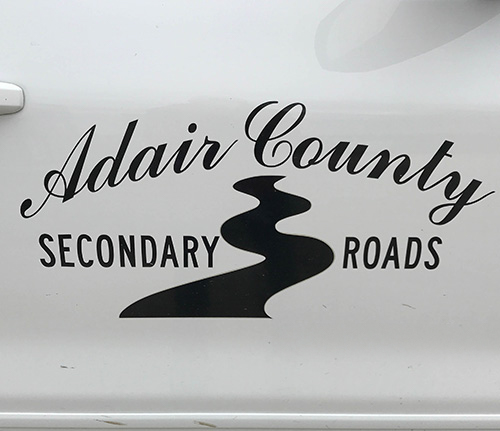 Example roadside program names:
Example roadside program names:
- Shelby County Roadside Management
- Dallas County Integrated Roadside Vegetation Management Program
- Linn County Right of Way Vegetation Management Program
- City of Center Point IRVM Program
Goals and Objectives
Goals are broad, long-term outcomes, while objectives are short-term, measurable actions taken to achieve goals.
Goals
Examples of roadside program goals excerpted from IRVM plans are listed below. Some programs categorize these as short-term goals (e.g., 0–5 years), medium-term goals (e.g., 5–10 years), or long-term goals (e.g., 10–20 years).
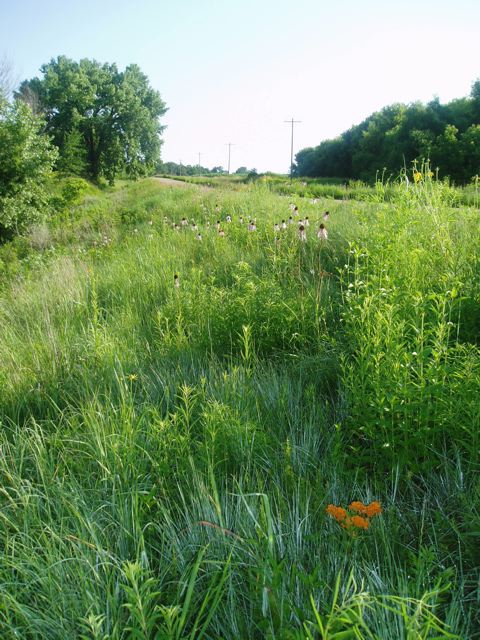
- Recognize and stop the spread of newly introduced invasive plant species in roadsides countywide before they become a problem.
- Minimize the use of herbicides and other chemicals to manage or eliminate undesirable plants. This includes the incorporation of prescribed burning, spot-spraying, and strategic use of herbicides, pesticides, mowing, and tree removal.
- Reduce erosion on county road construction projects by seeding and providing adequate erosion control. Use a long-term integrated management program that promotes desirable, self-sustaining plant communities. Whenever practicable, native plant communities are incorporated with roadside vegetation plantings.
- Enhance the scenic qualities of roadsides and their capacity as habitats for wildlife.
- Cultivate a communications strategy to build community support for the roadside management program.
- Develop a neighborly policy for dealing with right-of-way encroachment issues.
- Preserve and manage remnant prairie plant communities in the right-of-way through monitoring, prescribed fire, and brush removal.
Objectives
Here are some examples of specific measurable roadside program objectives from the Dallas County IRVM plan:
- Spray at least 30 gallons of basal bark herbicide annually to control woody invasive plants. Encourage district operators to perform these treatments.
- Monitor mowing operations by secondary road personnel and make recommendations as requested. Encourage prescribed use of mowing to limit impacts on plant and animal resources in the right-of-way and keep the road department in adherence with Iowa Code 314.17.
- Mow all first-year plantings once during the growing season. Mowing will be conducted between late June and early August. Mow plantings established for two years or more only as necessity and manpower dictate.
- Update the website pages related to roadside management annually. Provide two press releases per year about roadside vegetation management to local newspapers. Provide public service announcements and take advantage of other opportunities for exposure.
To get ideas for other goals and objectives that would be appropriate for your county or city, see a sampling of approved IRVM plans on the LRTF website.
IRVM Plan
Counties and cities that want to apply for Living Roadway Trust Fund (LRTF) grants and request free native seed will need to submit to the LRTF an IRVM plan that is signed by the appropriate county or city officials. To formulate the plan, counties and cities will use one of two plan outlines: the IRVM Plan Outline for Counties, State Agencies and Cities over 10,000 in Population form, or the IRVM Plan for Cities Under 10,000 Population form. These forms and approved plans to serve as examples are on the LRTF website.
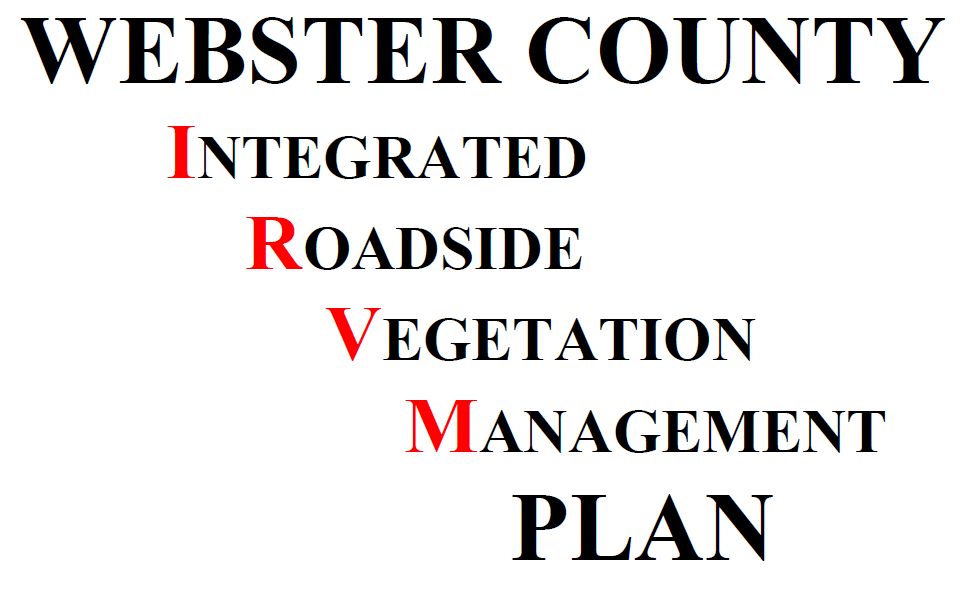
For most parts of the plan outline, roadside managers and other staff will be able to incorporate information already gathered and created during the new program's planning and implementation. The plan outline may be more or less extensive than the county or city’s internal program documentation. The LRTF coordinator is available for any questions that arise as you work on your plan.
Email the final plan to the LRTF coordinator for approval. Both IRVM plans and LRTF grant applications must be submitted by June 1. Once approved, plans should be updated and submitted for review by the LRTF coordinator every five years.
IRVM plans developed prior to 2015, when the LRTF implemented the latest plan requirements, are considered inactive. Counties or cities who do not have plans that meet the latest requirements are ineligible to apply for LRTF grants or request native seed.
Staffing and the Percentage of Time Each Staff Member Will Dedicate to the Program
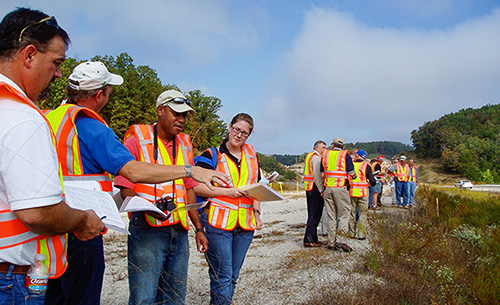
Identify which staff member will implement the plan. County or city officials will sometimes have someone who is already on staff implement the plan. More often, counties will create a new roadside vegetation manager position.
Ideally, the roadside manager will have wide-ranging knowledge and skills. The best candidates will have a solid background in operating heavy equipment, such as tractors, mowers, chainsaws, pickup trucks, trailers, skid loaders, tree planters, prescribed fire equipment, hand tools, seeders, and chemical spray equipment. They will also have good communication skills. Experience working with natural resources, vegetation, or both is an important bonus. Candidates must like a challenge and be willing to learn as they go. The county or city may hire the roadside manager before developing the IRVM plan and conducting the roadside vegetation inventory so the roadside manager can be involved in developing the plan. Conversely, the department hiring the roadside manager may prefer to write the plan first to articulate their vision for the program and develop local support for hiring a roadside manager to implement the plan. A generic position description (Appendix 2B) can be customized to fit your county’s situation.
Most roadside managers are responsible for at least 2,500 acres of roadside vegetation. They will be able to get more done if they have the assistance of a permanent or temporary technician and summer help. With proper funding, a roadside program has a sufficient workload to employ
- a full-time roadside manager/vegetation specialist,
- a full-time or nine-month roadside technician/assistant roadside manager; and
- two seasonal employees.
Results from the latest roadside manager salary survey can help when budgeting for staff salaries. The most recent survey results can be obtained from the Tallgrass Prairie Center roadside program manager. Potential funding sources in the county budget for roadside positions include the rural basic fund, secondary road fund, road clearing appropriation, and county conservation board budget. See Appendix 2B for a sample roadside manager job description.
The Full-Time Roadside Manager
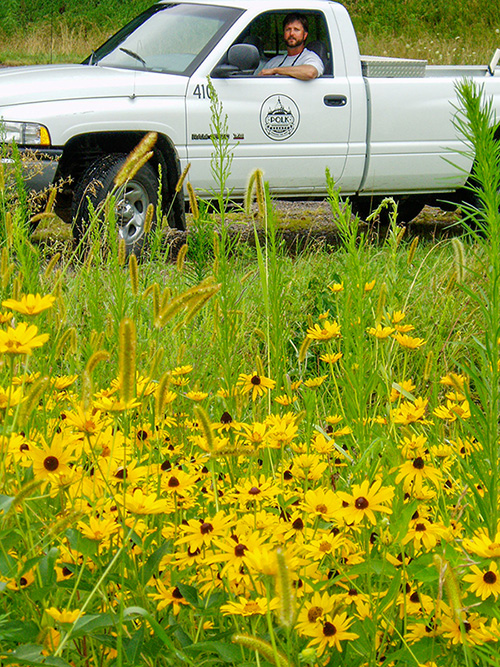
The best way to achieve common roadside program goals is to hire a full-time roadside manager. As the person overseeing all roadside vegetation management duties, the roadside manager is focused and motivated to
- control weeds and brush in a timely, effective manner;
- save money by conducting more in-house operations;
- stay current with the latest products and technologies;
- establish and maintain healthy stands of native vegetation;
- install and maintain erosion control measures; and
- submit LRTF applications to bring in additional resources that address county needs.
The roadside manager takes ownership of managing the county’s roadsides with pride and accountability. When one person coordinates every aspect of the program, the result is better roadsides. Although cities may not have the resources to hire a full-time roadside manager, they need to designate in their integrated roadside vegetation management (IRVM) plans who will lead the effort to manage roadsides using the IRVM principles.
A Less Expensive Way to Get Started
A few Iowa counties have planted a lot of native vegetation in roadsides without a roadside manager. These counties do not have the same level of vegetation management as those with roadside managers, but they do have access to the LRTF. The following are examples of how this can be accomplished:
- The county engineer and conservation board director work together. The engineer applies for native seed from the Tallgrass Prairie Center’s Iowa Roadside Management Office at the University of Northern Iowa, or purchases seed for ditch cleanouts and roadside projects, and conservation personnel does the planting.
- The county identifies a current employee (e.g., the engineer or somebody working in the engineer’s department) who wants the county to use integrated roadside vegetation management. In addition to their regular duties, the employee applies for the native seed and works with road maintenance personnel to plant it.
- The county identifies a vegetation-savvy employee, most likely in the conservation department, and makes applying for LRTF grant funding and planting native vegetation in the roadside part of that employee’s job.
Hopefully, these and other similar nascent efforts by counties attempting to establish the use of IRVM principles act as catalysts to eventually hire full-time roadside managers. Maintaining healthy roadsides with native vegetation takes a sustained, focused effort. A county board of supervisors supporting the implementation of IRVM principles is necessary but not sufficient to make it happen—having an employee in a critical position who wants the program to succeed is crucial.
Steering Committee: Community Partners Who Can Help You With Referrals, Advertising, Implementation, and More

An IRVM steering committee (also known as an advisory committee) meets regularly to stay updated on the roadside program’s activities and challenges and provides guidance. The committee can also help spread the word within the community about the benefits of having a program and provide political support as needed.
A steering committee may be formed at any time but most often evolves from the committee formed during the initial effort to establish a program or is formed when a roadside manager is hired. A committee typically meets 2–4 times a year and consists of 5–10 members representing the private and public sectors. The committee may be comprised of some of the following members:
- member of the board of supervisors or city council
- Their support is critical, so the inclusion of at least one elected official is highly recommended.
- County/city engineer
- road superintendent/foreman
- weed commissioner (if this is a separate position from the roadside manager)
- member of the county conservation board
- key members of the original committee formed to establish a roadside program
- educator
- county soil and water conservation district representative
- federal Natural Resources Conservation Service employee
- residents interested in roadside management
- representative from a conservation organization such as Trees Forever or Pheasants Forever
- representative from a farming organization such as Farm Bureau, Soybean Association, Corn Growers Association, or someone involved in the agricultural industry
The county engineer, conservation board director, or initial IRVM committee members may recommend people to appoint but the county board of supervisors or city council has the authority to appoint members. Committee members often serve three-year staggered terms, which can initially be structured as follows:
- 3 members—1-year term
- 3 members—2-year term
- 4 members—3-year term
After this initial setup, when the terms are up, all subsequent terms would be for 3 years.
Committees elect chairpersons and secretaries, and meetings are subject to Chapters 21 and 22 of the Iowa Code concerning open meetings and public records.
Program Organization/Location
When deciding within which department to locate a county roadside program and who should supervise the roadside manager, keep in mind that greater independence allows for better planning and timely operations. Sometimes, a department may need to be restructured or reorganized to give roadside management personnel the autonomy to meet objectives. County programs can operate successfully within the engineer’s office, the county conservation board, or as an independent department. All three have advantages.
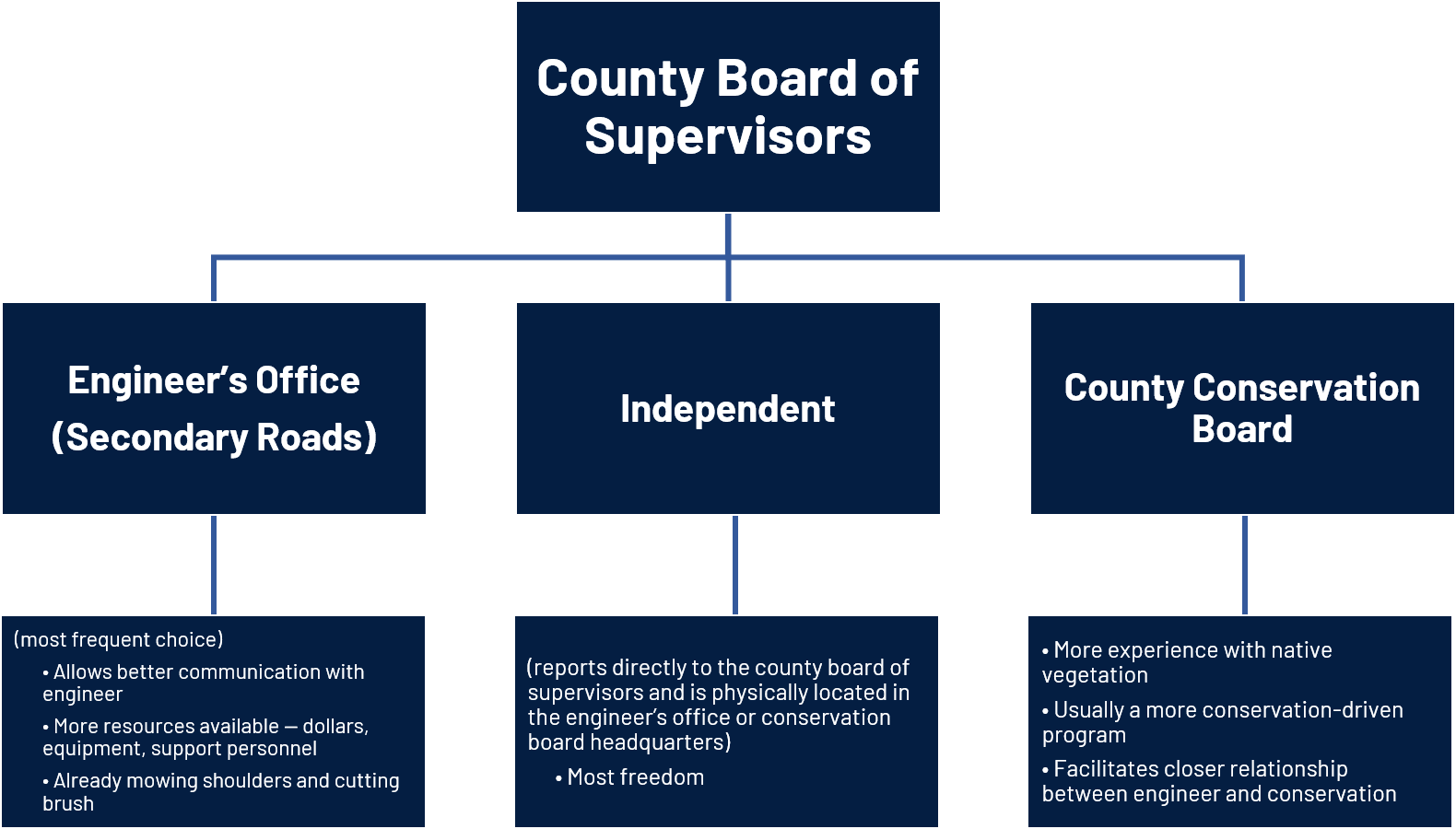
Generating Support for the Program
Members of the steering committee can generate goodwill for the program by communicating within their networks. Regular communication between the roadside manager and the committee members is important so that members know about the roadside manager’s projects and what information to relay.
Working on projects that visibly show progress in a relatively short amount of time, such as brush control or seedings with signage, can help garner support for a new program. The appropriate level and type of publicity for a new program can vary depending on the county or city’s goals and progress on specific projects.
Chapter 3: Communication includes many ideas for developing and maintaining both internal and public support for a roadside program.
How the Program Will Be Evaluated
Completing an IRVM plan and a county vegetation management survey can identify goals and objectives that serve as the basis for evaluating the program. Examples of ways counties have evaluated aspects of program success include:
- analyzing results of countywide roadside vegetation inventories;
- creating annual project reports documenting plant establishment for larger plantings (more than one acre) adjacent to hard-surfaced roads;
- evaluating the effectiveness of herbicides and other weed control measures in managing problem areas with a lot of invasive species; and
- examining the program's progress annually at one of the IRVM advisory committee’s regular meetings.
Budget
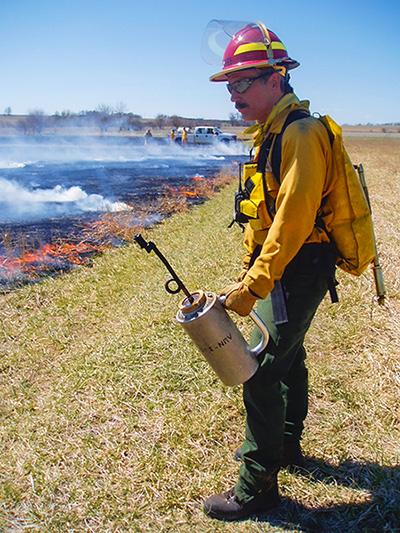
These expenses should be considered when anticipating the cost of a program:
- full-time roadside manager salary and overtime pay
- full-time technician salary and overtime pay
- temporary assistants’ salaries and overtime pay
- contract labor
- FICA payroll tax—county or city contribution
- Iowa Public Employees Retirement System (IPERS) city or county employer contribution
- employee health, life, dental, and long-term disability insurance
- herbicides
- stationery and other printing costs
- minor equipment and hand tools
- staff education and training
- operations and construction equipment
- fertilizer and seed
In the end, weed and brush control objectives are balanced against environmental concerns and limited county or city resources. With that in mind, determine an appropriate allocation of resources. Also, determine how much might be saved with better organization and efficiency.